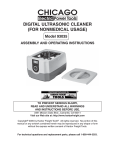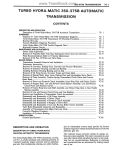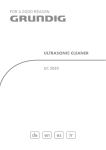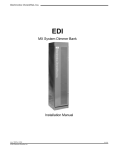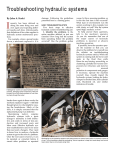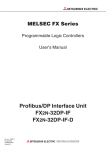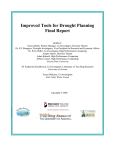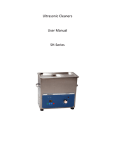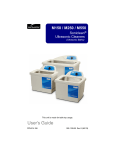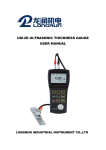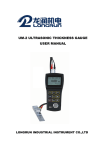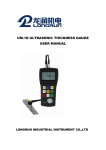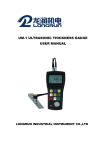Download Power Cube: User Manual Warnings Hydraulic System Maintenance
Transcript
Power Cube: User Manual Warnings • • • • • • • • Never force a hydraulic connection that doesn’t seem to fit. Use only fasteners of the proper size. Beware of corroded, loose or missing fasteners. Do not operate hydraulics below minimum rated flow. Do not open vent or drain valves while system is pressurized. Lock out power before working on system. Use proper lifting and support equipment to avoid injury. Properly decontaminate skin, clothing and tools. Hydraulic System Maintenance Safety & Cleanliness Wear your Personal Protective Equipment. Hydraulic systems operate under very high pressures. Shut the system down and relieve system pressure before opening any part of the system that is under pressure. Do not allow spray from any high pressure leak to contact any part of the body, as serious injection injuries may result. Pumps, valves and motor may become hot; be cautious of incidental contact between bare skin and hot surfaces. Keep hands and clothing away from moving parts of the system. No grinding or welding operations should be done in the area where hydraulic components are being installed. All cylinder, valve, pump and hose connections should be sealed and/or capped until just prior to use. When installing pumps or motors, always align coupling halves as closely as possible, within 0.007 inch. Generic • Any intervention must be carried out with pressure and tension released.” • Check for visible leaks (particularly at connections). Tighten or seal if necessary. • Check state of hydraulic fluid. Completely replace if deteriorating (sunk color, odor, milky aspect). • Check hydraulic fluid level. Refill with same viscosity and to same line if necessary. • If system is to be shut down for a long time, leave hydraulic oil in the circuit. • Replace hydraulic fluid: every 24 months of use • Replace hydraulic fluid filters: every 12 months • Inspect hoses for damage, blisters, leaks or fraying. Replace if necessary. • Ensure pressure relief valve is not held partially open by contamination. • Check for corroded or loose fasteners. Open Source Ecology: Civilization Starter Kit v.0.01 1 Power Cube: User Manual Pump/Motor Maintenance Performance parameters: • • • • • • suction pressure (Ps) discharge pressure (Pd) flow (Q) pump speed (Nr) pumpage properties power Measure power with a clip on amp meter. It’s not all that accurate, but it’s good for a baseline comparison. Locate suction and discharge gauges to determine (Ps) and (Pd). • • • • normal (perpendicular) to the pipe wall on centerline of pipe in a straight section of pipe not in the bottom or top (avoid air and solids) Measure flow. It’s difficult if a permanent flow meter isn’t installed. • insert a pitot tube into the pipe • use a doppler or transitime device (non-intrusive) • each measuring device must be calibrated (don’t underestimate the importance of this) Measure vibration • There is no absolute vibration reading that indicates a problem. • Since each installation is unique, the best thing to do is take measurements at first power-on and at regular intervals to establish a baseline and trending. • When possible, measure vibration amplitude at these locations: ͳͳ motor outboard & inboard bearing housings in vertical & horizontal direction ͳͳ motor axial direction ͳͳ pump outboard & inboard bearing housings in vertical & horizontal direction ͳͳ pump axial direction • Also record operating mode of whatever is being measured. The vibration will increase as the pump/motor works outside of its Best Efficiency Point (BEP; that is normal. • Vibration frequency will indicate what is causing the problem while amplitude indicates how bad the problem is. Bearing manufacturers will publish information on bearing defect frequency as a function of bearing speed. Open Source Ecology: Civilization Starter Kit v.0.01 2 Power Cube: User Manual Measure temperature • Fluid (oil and water) must remain within certain temperature boundaries. • Bearings must not exceed a certain temperature. Measure shaft play Use a dial indicator, mounted solidly to something that doesn’t move in relation to the shaft, to measure how far out of perfect round the shaft is. Anything more than 2 mil/in (0.002in) is unacceptable at any speed. 1 mil/in is acceptable up to about 4,000RPM. Fluid Maintenance Control the temperature • Excessive temperatures will oxidize the oil and can lead to varnish and sludge deposits • Running the temperature too low will allow condensation in the reservoir and increase the likelihood of pump cavitation • Typical industrial hydraulic system temperatures often range between 110 to 150ºF • Keep systems which operate on a water based fluid below 140ºF to prevent the water from evaporating • To allow heat to radiate from the system, keep the outside of the reservoir clean and the surrounding area clear of obstructions • Keep air-cooled radiators free of dirt • Normal temperature drop for most oil coolers is 5 to 10ºF • Reservoirs should be filled to the proper level to allow enough time for the heat to dissipate. Keep the area clean Even new systems may be contaminated and should be cleaned before use. Prevent contaminants such as dirt, water, cutting fluids, and metal particles from entering the system around the reservoir cover, openings for suction and drain lines, through breather fill openings, past piston rod packing, and through leaks in pump suction lines. Keep the fluid clean • Reservoirs should be filled to the proper level to allow time to shed water and dirt • Deposits caused by oil degradation can plug valves and suction screens and cause hightolerance servo valves to seize and/or operate sluggishly • To prevent contamination before use, store new fluid in a protected area and dispense it in clean, DEDICATED containers. • Clean the fill cap before removing it to add hydraulic fluid. • Inspect fluid filters frequently and change or clean them before they go into bypass mode. Follow an oil analysis program Open Source Ecology: Civilization Starter Kit v.0.01 3 Power Cube: User Manual • Contaminants act as a catalyst for wear. This generated wear debris further acts as a catalyst for additional component wear. • With an effective oil analysis program, you can safely increase the standard 1 year interval while at the same time provide yourself with an “early warning” of possible mechanical problems. • At minimum, check your critical and large volume hydraulic systems at least annually by oil analysis. • Semi-annual or even quarterly sampling intervals may be required for extremely critical machines. In modern equipment using servo valves, oil degradation can be even more damaging. High pressure (up to 4000 psi), high temperatures, and small reservoirs stress the fluid. With minimal residence time and high pressures, entrained air bubbles can cause extreme localized heating of the hydraulic fluid. This results in nitrogen fixation that, when combined with oil oxidation, can form deposits which will plug oil filters and cause servo valves to stick. On critical NC systems, use quick disconnect hoses and filter all oil added to the reservoir through a 5 micron filter. Portable filters will supplement permanently installed filters and should be constantly rotated from system to system regardless if you think the system requires filtering or not. Systems should be filtered long enough to pass the total volume of oil through the filter at least 10 times. Portable filters should be used when transferring new oil from drums or storage tank to a system — especially for NC machines. 10 Point Check Perform weekly 1. Check fluid levels. Add oil (if needed) via portable filtration(if available). DO NOT MIX OILS! Use the same oil brand andviscosity grade that is being used in the system. 2. Inspect breather caps, breather filters and fill screens — DO NOT punch holes in screens in order to expedite adding oil. 3. Check filter indicators and/or pressure differential gages. 4. Visually inspect all system hoses, pipes, pipe connections for leaks and frays. Hydraulic fluid leakage is a common problem for industrial systems. Excessive leakage is an environmental and safety hazard, increases waste streams and oil consumption, and, if ignored, canreduce the system capacity enough to overheat the system. 5. Check system temperature via built-in thermometers or hand-held infrared detectors. Normal temperature range for most systems is110-140ºF. If temperatures are high, check cooler operation andrelief valve settings. 6. Visually inspect the inside of the reservoir for signs of aeration (via the fill hole using a flashlight). Aeration is a condition in which discrete bubbles of air are carried along in the stream of oil as it enters the pump. Visual signs of aeration in the reservoir are generally Open Source Ecology: Civilization Starter Kit v.0.01 4 Power Cube: User Manual foaming and/or little whirlpools taking small gulps of air into the suction strainer. Causes of aeration include: low fluid levels; airleaks in the suction line; low fluid temperature; fluid is too viscous to release air or maintain suction at the pump; or faulty shaft seals.When air leaks are suspected on the suction line, smotheringthesepoints with oil will usually pinpoint the leaks by creating a markedchange in pump noise. A pump ingesting air sounds as if it weregargling marbles. 7. Listen to the pump for the signs of cavitation. Cavitation is slightly more complicated than aeration, but bares somesimilarities. Cavitation occurs when air is released from the hydraulic oil during momentary depressurization at the pumpsuction and then imploded onto metal surfaces upon discharge.These implosions are extremely destructive to pump surfaces. A cavitating pump will emit a high-pitched whine or scream. Causes of cavitation are the same as those of aeration with the exception of suction side air leaks. How do you discern aeration from cavitation? One way is to install a vacuum gage on the suction side and make sure the pressure is equal too or greater than that prescribed by the pump manufacturer. Foaming in the reservoir is usually the telltale sign of aeration. 8. Inspect a small sample of fluid for color, signs ofcontamination and odor. Keep in mind that visual inspectionis limited in that it will only detect signs of excess contamination. 9. Scan electrically controlled servo valves with an infraredthermometer. High valve and solenoid temperatures(over 150ºF) usually indicate the valve is sticking. 10.Scan the electric drive motor with for housing hot spots and rotor bearing temperatures using an infrared thermometer. Change The Fluid 1. 2. 3. 4. 5. 6. 7. Drain the system while the fluid is hot to keep contaminants in suspension. Empty fluid from cylinders, accumulators and lines that might not drain properly. Mop, siphon, or pump out oil left in the reservoir. Wipe reservoir clean with lint free rags and remove rust and free paint. Replace or clean filter elements and strainers and clean filter housings. Refill the system with new fluid making sure to vent high points. Restart and check system for proper operation. Oil Analysis 1. Identify “Mission Critical” Equipment It’s not necessary to perform oil analysis on every single lubricated system. Identify critical applications that would seriously jeopardize production if they were to shut down unexpectedly. 2. Register Your Equipment It is important to have your equipment properly registered with a lab. This supports routine trending and plays a key role in early detection of lubricant or equipment problems. There’s no need for you to decide which tests are appropriate for a particular application because the lab has already established test slates for specific applications. 3. Establish Best Practices Establish a consistent “how-to” practice for taking oil samples from your equipment and train your maintenance personnel to use this practice. Correct sampling practices are critical to the value received from the analysis data. This extremely important step rarely gets the attention it needs. Open Source Ecology: Civilization Starter Kit v.0.01 5 Power Cube: User Manual 4. Sample Retrieve samples in accordance with your best practice and send them to the lab as soon as possible. Samples that are set aside may deteriorate and give non-representative results. 5. Analyze A thorough analysis, keyed on trends, helps determine your systems’ conditions. 6. Interpret Reviewing the results and determining what, if any, action is required can make or break a successful program. It’s important to remember that an alert sample does not necessarily mean imminent failure. Seek consultation on alert samples and re-sample to confirm present data before taking massive corrective action. 7. Take Corrective Action and Document, Document, Document!!! As always, documentation is the key to knowing where you’ve been and where you’re going. Document corrective actions resulting from oil analysis. Mechanical System Maintenance Engine Maintenance • • • • • • • • • Check oil level: every 5 hours Change oil and oil filter: after first five hours Change oil: every 50 hours or every season (more often if dirty conditions) Change oil filter: every 100 hours or every season Replace foam air cleaner: every 25 hours or every season Replace paper air filter: every 25 hours or every season Replace paper air filter w/ foam air cleaner: every 100 hours or every season Replace spark plugs: every 100 hours or every season Replace fuel filter: every 100 hours or every season Open Source Ecology: Civilization Starter Kit v.0.01 6






